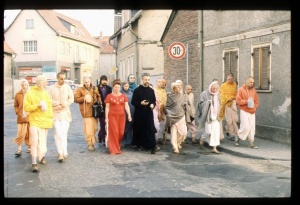CC Madhya 6.81

A.C. Bhaktivedanta Swami Prabhupada
TEXT 81
- śiṣya kahe,—‘īśvara-tattva sādhi anumāne’
- ācārya kahe,—‘anumāne nahe īśvara-jñāne
SYNONYMS
śiṣya kahe — the disciples said; īśvara-tattva — the truth of the Absolute; sādhi — derive; anumāne — by hypothesis; ācārya kahe — Gopīnātha Ācārya replied; anumāne — by hypothesis; nahe — there is not; īśvara-jñāne — real knowledge of the Supreme Personality of Godhead.
TRANSLATION
The disciples of the Bhaṭṭācārya said, “We derive knowledge of the Absolute Truth by logical hypothesis.” Gopīnātha Ācārya replied, “One cannot attain real knowledge of the Supreme Personality of Godhead by such logical hypothesis and argument.”
PURPORT
The Māyāvādī philosophers in particular make certain hypotheses about the Absolute Truth. They reason that in the material world we experience that everything is created. If we trace the history of anything, we find a creator. Therefore there must be a creator of this huge cosmic manifestation. By such reasoning they come to the conclusion that a higher power has created this cosmic manifestation. The Māyāvādīs do not accept this great power to be a person. Their brains cannot accommodate the fact that the huge cosmic manifestation can be created by a person. They doubt this because as soon as they think of a person, they think of a person within the material world with limited potency. Sometimes the Māyāvādī philosophers will accept Lord Kṛṣṇa or Lord Rāma as Bhagavān, but they think of the Lord as a person having a material body. The Māyāvādīs do not understand that the Supreme Personality of Godhead, Kṛṣṇa, has a spiritual body. They think of Kṛṣṇa as a great personality, a human being, within whom there is the supreme impersonal power, Brahman. Therefore they finally conclude that the impersonal Brahman is the Supreme, not the personality Kṛṣṇa. This is the basis of Māyāvādī philosophy. However, from the śāstras we can understand that the Brahman effulgence consists of the bodily rays of Kṛṣṇa:
- yasya prabhā prabhavato jagad-aṇḍa-koṭi-
- koṭiṣv aśeṣa-vasudhādi-vibhūti-bhinnam
- tad brahma niṣkalam anantam aśeṣa-bhūtaṁ
- govindam ādi-puruṣaṁ tam ahaṁ bhajāmi
“I serve the Supreme Personality of Godhead, Govinda, the primeval Lord, the effulgence of whose transcendental body is known as the brahmajyoti. That brahmajyoti, which is unlimited, unfathomed and all-pervasive, is the cause of the creation of unlimited numbers of planets with varieties of climates and specific conditions of life.” (Brahma-saṁhitā 5.40)
Māyāvādī philosophers study the Vedic literature, but they do not understand that in the last stage of realization the Absolute Truth is the Supreme Personality of Godhead, Kṛṣṇa. They do accept the fact that there is a creator of this cosmic manifestation, but that is anumāna (hypothesis). The Māyāvādī philosophers’ logic is something like seeing smoke on a hill and concluding that there is a fire. When there is a forest fire on a high hill, smoke is first of all visible. Since it is known that smoke is created when there is fire, from seeing the smoke on the hill one can conclude that a fire is burning there. Similarly, from seeing this cosmic manifestation the Māyāvādī philosophers conclude that there must be a creator.
The disciples of Sārvabhauma Bhaṭṭācārya wanted evidence to show that Śrī Caitanya Mahāprabhu was actually the creator of the cosmic manifestation. Only then would they accept Him as the Supreme Personality of Godhead, the original cause of creation. Gopīnātha Ācārya replied that one could not understand the Supreme Personality of Godhead by guesswork. As Kṛṣṇa says in the Bhagavad-gītā (BG 7.25):
- nāhaṁ prakāśaḥ sarvasya yoga-māyā-samāvṛtaḥ
- mūḍho ’yaṁ nābhijānāti loko mām ajam avyayam
“I am never manifest to the foolish and unintelligent. For them I am covered by My eternal creative potency [yogamāyā]; and so the deluded world knows Me not, who am unborn and infallible.” The Supreme Personality of Godhead reserves the right of not being exposed to nondevotees. He can only be understood by bona fide devotees. Lord Kṛṣṇa says elsewhere in the Bhagavad-gītā (BG 18.55), bhaktyā mām abhijānāti: “One can understand Me only by the devotional process.” In the Fourth Chapter of the Bhagavad-gītā (BG 4.3) Lord Kṛṣṇa says, bhakto ’si me sakhā ceti rahasyaṁ hy etad uttamam. Here Lord Kṛṣṇa informs Arjuna that He is disclosing the secrets of the Bhagavad-gītā to him because he is His devotee. Arjuna was not a sannyāsī, nor was he a Vedāntist or brāhmaṇa. He was, however, a devotee of Kṛṣṇa. The conclusion is that we have to understand the Supreme Personality of Godhead from the devotees. Śrī Caitanya Mahāprabhu Himself says, guru-kṛṣṇa-prasāde pāya bhakti-latā-bīja (CC Madhya 19.151).
More evidence can be cited to show that without the mercy of a devotee or the mercy of Kṛṣṇa, one cannot understand what is Kṛṣṇa and what is the Supreme Personality of Godhead. This is confirmed in the next verse.